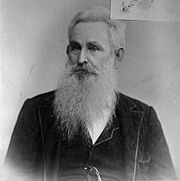
Bethel Coopwood
Bethel Coopwood (1827–1907) was a soldier in the Mexican–American War and the American Civil War, a lawyer, judge, and historian.
Early life[]
Coopwood was born on May 1, 1827, in Lawrence County, Alabama. He moved to Texas in 1846 and fought in a cavalry regiment in the Mexican–American War. In 1854 he moved to California, where he was admitted to the bar, practicing in Los Angeles. Following the killing of Sheriff James R. Barton by the Flores Daniel Gang, Coopwood led twenty-six El Monte men, as a division of the posse in the manhunt for the gang.[1]
In 1857, at the age of thirty he came to San Bernardino as part of a syndicate that purchased the balance of the Rancho San Bernardino from Ebenezer Hanks for $18,000.[2] Hanks had previously purchased a one-third interest in the grant, with Amasa Lyman and Charles C. Rich leaders of the Mormon colonists of San Bernardino from the original grantee José del Carmen Lugo.
Coopwood remained in San Bernardino until 1861, as realtor and a lawyer and with an excellent knowledge of Spanish and a number of Mexican clients, most of whom were very well off.[3] Coopwood although of southern sympathies himself, sheltered the pro Union Doctor Ainsworth in his own home from a mob of pro southern sympathies and was wounded in the shootout that was the climax of the 1859 "Ainsworth-Gentry Affair." [4] That same year he married Josephine Woodward and they eventually had fourteen children.
In the bitterly contested campaign of 1860, Charles W. Piercy was nominated for member of the 1st District of the California General Assembly by one party, and W. A. Conn the incumbent, by the other. Piercy was elected, but there was a claim of fraud. The accusation was that polls at Temescal, maintained by a resident named James Greenwade, kept open shop for three weeks and that whenever candidate Piercy was in need of more votes, they were furnished from this precinct. The case was taken to court, where the two opposing lawyers, H. M. Willis and Bethel Coopwood, had a fight in court wherein Coopwood sustained a slight wound, but won the case.[5]
Civil War[]
In 1861, Coopwood disposed of his interests in California and returned to Texas. He entered the Confederate Army as a captain in the cavalry and served until 1863. In 1861, he formed the San Elizario Spy Company or Coopwood Spy Company, an Independent Volunteer Company of cavalry with men that came with him from California. He commanded the Confederate forces in the Battle of Canada Alamosa, largest of several small battles that occurred in Confederate Arizona near the border with New Mexico Territory. He and his company served in Sibley's New Mexico Campaign. He was ill with smallpox during the Battle of Valverde but recovered in time to join the army at the Battle of Albuquerque and the Battle of Peralta. He was responsible for saving the remnants of Sibley's army, 1800 men, from Union pursuit by finding a path for them through the rugged mountains west of the Rio Grande to the Mesilla Valley. He was later promoted to Major and then Lt. Colonel.[6]
Later life[]
After the Civil War he spent a year in Coahuila. He returned to Texas and became recognized as an able lawyer and Spanish scholar in the lower Rio Grande valley. He contributed articles to and wrote book reviews for early issues of the Texas State Historical Association Quarterly, in which he published "Notes on the History of La Bahía del Espíritu Santo" in 1898–99 and "The Route of Cabeza de Vaca" in 1899–1900. Judge Coopwood died in Austin on December 26, 1907.[7]
Notes[]
- ↑ Hubert Howe Bancroft, Popular tribunals, Volume 1, History Company, San Francisco, 1887, p.500
- ↑ Some of the settlers, being Josephites and not in sympathy with Young's policy or the practice of polygamy, remained in the valley, and the remainder of the church property was placed in the hands of Ebenezer Hanks, who had previously purchased a one-third interest in the grant, and who later sold the property to Richard G. Allen. F. L. Tucker, W. A. Conn and Bethel Coopwood. John Brown, James Boyd, History of San Bernardino and Riverside counties, p. 48
- ↑ John Brown, James Boyd, History of San Bernardino and Riverside counties, p. 122
- ↑ John Brown, James Boyd, History of San Bernardino and Riverside counties, p. 148
- ↑ John Brown, James Boyd, History of San Bernardino and Riverside counties, p. 148-149 Later in 1861 Piercy was killed in a duel with another assemblyman, Daniel Showalter.
- ↑ Jerry D. Thompson, Civil War in the Southwest: recollections of the Sibley Brigade, Texas A&M University Press, 2001.
- ↑ Handbook of Texas Online - COOPWOOD, BETHEL.
External links[]
The original article can be found at Bethel Coopwood and the edit history here.